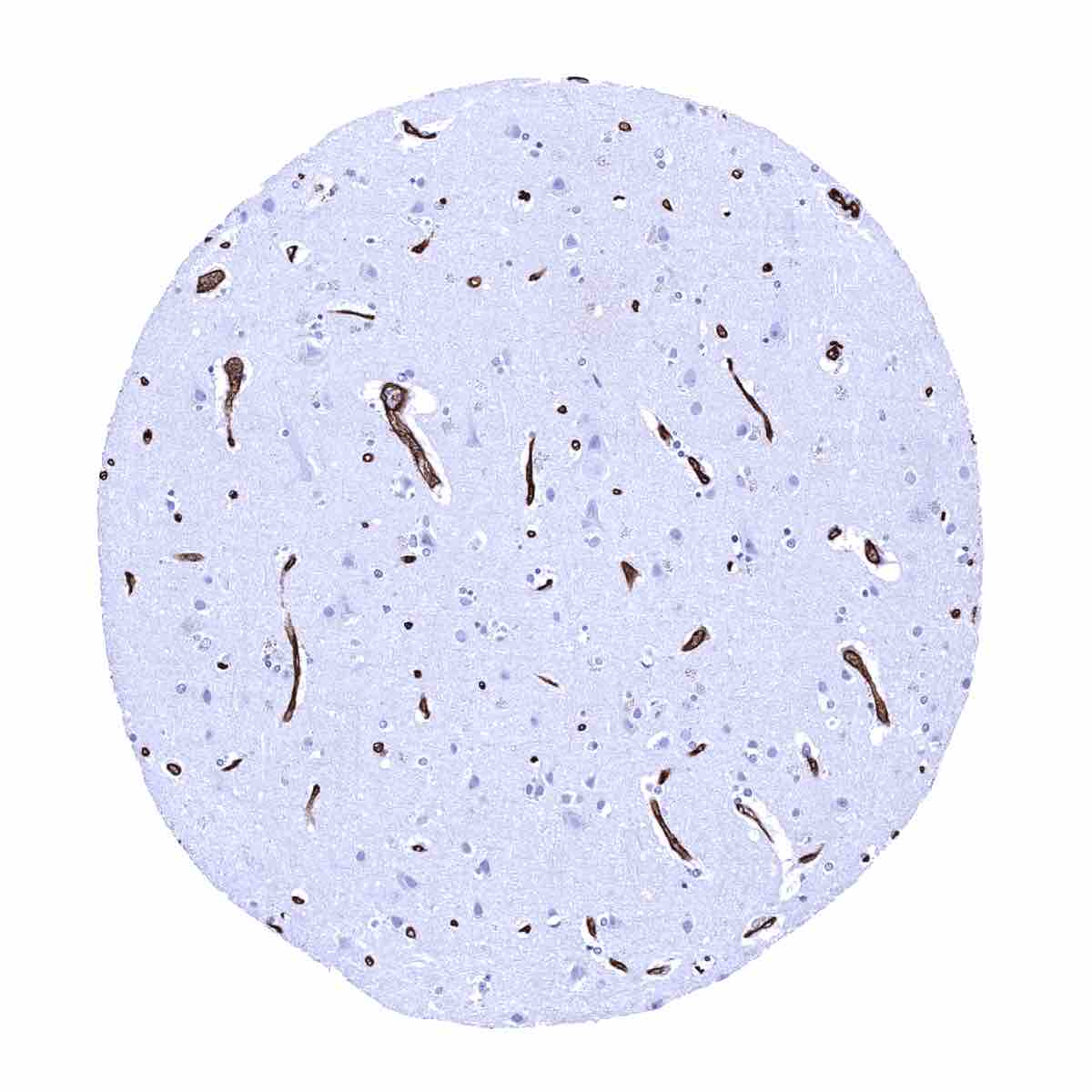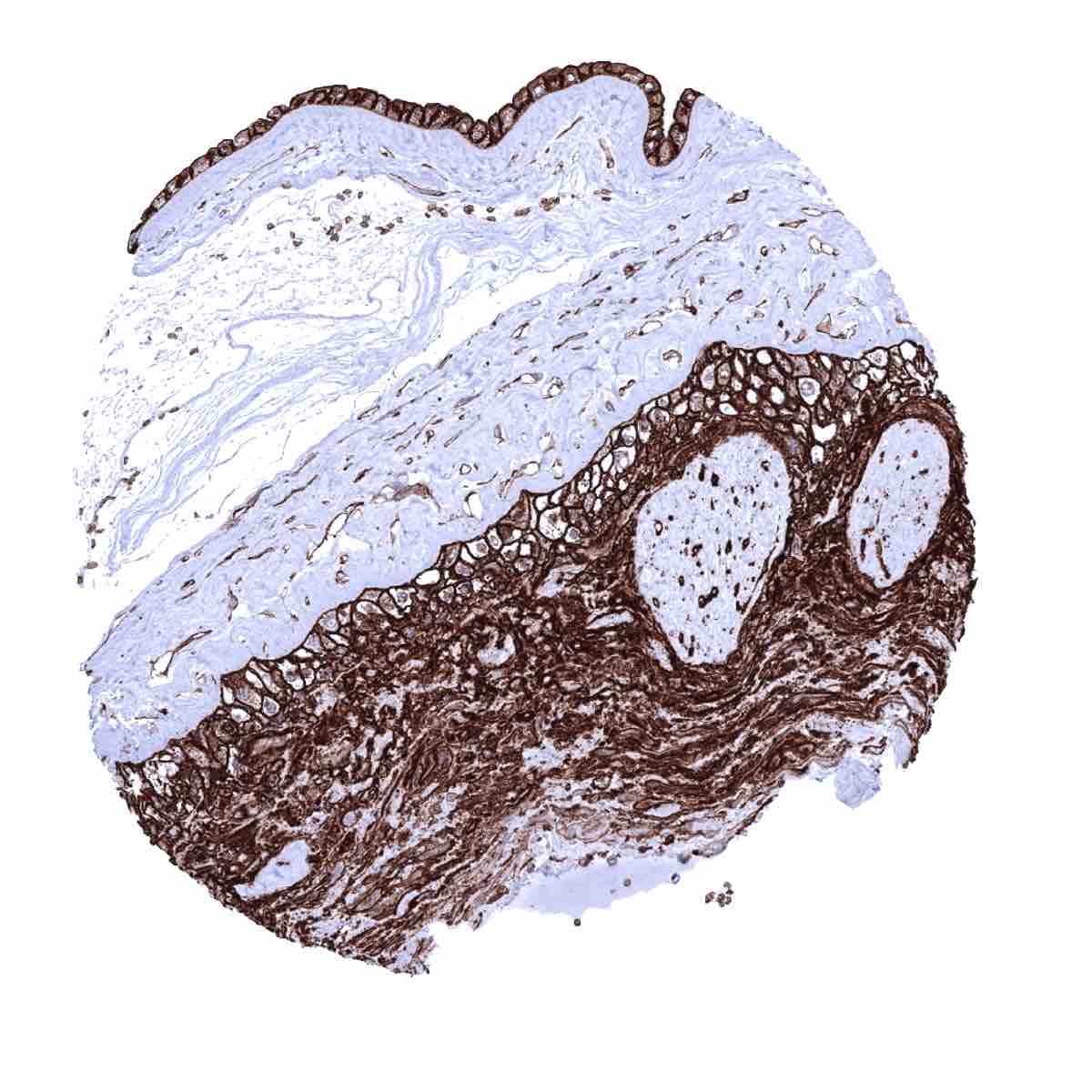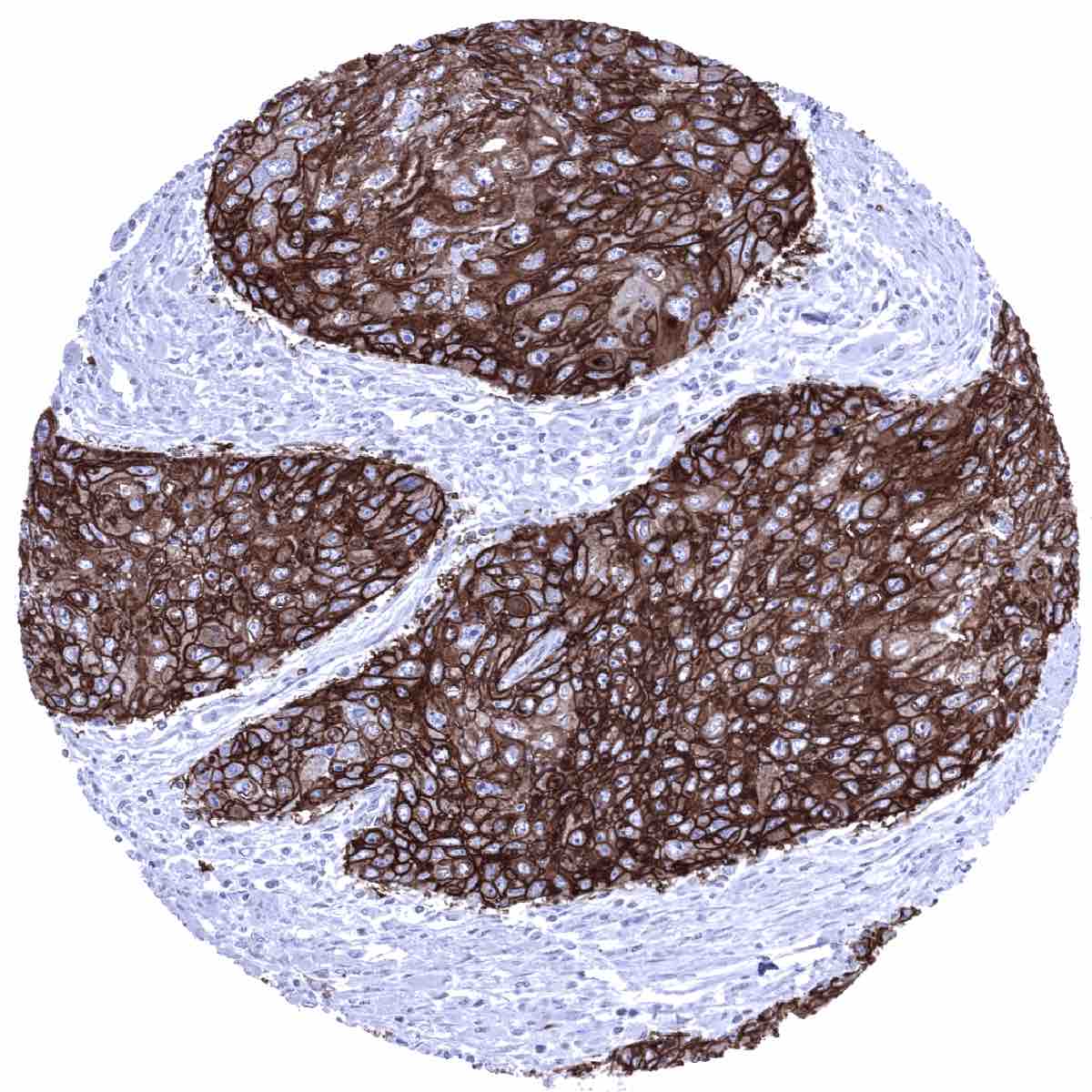295,00 € – 995,00 €
Product details
Synonyms = Erythrocyte/hepatoma glucose transporter; Glucose transporter type-1; GLUT1; GLUT1DS; GLUTB; GT1; GTG1; Gtg3; HepG2 glucose transporter; PED; RATGTG1; Solute carrier family 2, facilitated glucose transporter member 1 (SLC2A1)
Antibody type = Recombinant Rabbit monoclonal / IgG
Clone = MSVA-401R
Positive control = Brain: A strong GLUT1 staining of endothelial cells should be seen.
Negative control = Brain: GLUT1 staining should be absent in all cells/structures except blood vessels.
Cellular localization = Cell Surface
Reactivity = Human
Application = Immunohistochemistry
Dilution = 1:100 – 1:200
Intended Use = Research Use Only
Relevance of Antibody
GLUT1 is a key protein for transporting glucose through cell membranes.
Biology Behind
Glucose transporter 1 (or GLUT1), also known as solute carrier family 2, facilitated glucose transporter member 1 (SLC2A1) protein is coded by the SLC2A1 gene on chromosome 1p34.2. GLUT1 facilitates the transport of glucose across the plasma membranes of cells. Glut1 is also a receptor for vitamin C uptake and the human T-cell leukemia virus (HTLV) I and II. GLUT1 expression occurs in almost all tissues. The level of GLUT1 expression parallels the rate of cellular glucose metabolism. It is particularly high in erythrocytes and in endothelial cells of the blood–brain barrier. GLUT1 is often overexpressed in cancer because many tumors exert a metabolic switch from oxidative phosphorylation to glycolysis which requires an elevated uptake of glucose. In cancer GLUT1 represents a potential therapeutic target for GLUT1 inhibitors such as Bay-876.
Staining Pattern in Normal Tissues
Trop2 staining pattern in Normal Tissues with antibody MSVA-733R (images are shown in our “Normal Tissue Gallery”)
| Brain | Cerebrum | Negative. Strong endothelial staining of vessels. |
| Cerebellum | Negative. Strong endothelial staining of vessels. | |
| Endocrine Tissues | Thyroid | Epithelial cells are GLUT1 negative. |
| Parathyroid | Epithelial cells are GLUT1 negative. | |
| Adrenal gland | Epithelial cells are GLUT1 negative. | |
| Pituitary gland | Epithelial cells are GLUT1 negative. | |
| Respiratory system | Respiratory epithelium | Weak, predominantly cytoplasmic GLUT1 staining in (non-basal) cells of the respiratory epithelium. |
| Lung | Negative. | |
| Gastrointestinal Tract | Salivary glands | Negative. |
| Esophagus | Weak to moderate membranous and cytoplasmic GLUT1 staining of squamous epithelial cells, preferentially in the lower third. | |
| Stomach | Weak membranous and cytoplasmic, preferentially basolateral GLUT1 staining of surface epithelial cells. | |
| Duodenum | Epithelial cells are usually negative, but focal GLUT1 staining can occur (mostly weak). | |
| Small intestine | Epithelial cells are usually negative, but focal GLUT1 staining can occur (mostly weak). | |
| Appendix | Epithelial cells are usually negative, but focal GLUT1 staining can occur (mostly weak). | |
| Colon | Epithelial cells are usually negative, but focal GLUT1 staining can occur (mostly weak). | |
| Rectum | Epithelial cells are usually negative, but focal GLUT1 staining can occur (mostly weak). | |
| Liver | Negative. | |
| Gallbladder | GLUT1 staining of variable intensity can be seen focally in epithelial cells. | |
| Pancreas | A focal membranous GLUT1 staining of acinar epithelial cells can occasionally be seen. | |
| Genitourinary | Kidney | Usually GLUT1 negative, but few tubuli or collecting ducts may show a weak to moderate staining. |
| Urothelium | Weak to moderate membranous GLUT1 staining with decreasing intensity from the basal to the superficial cell layers. | |
| Male genital | Prostate | Usually GLUT1 negative, but a fraction of samples shows a faint GLUT1 staining in basal cells. |
| Seminal vesicles | A predominantly basolateral membranous GLUT1 positivity occurs in a fraction of epithelial cells. | |
| Testis | Negative. | |
| Epididymis | Negative. | |
| Female genital | Breast | Weak cytoplasmic GLUT1 staining of acinar cells. |
| Uterus, myometrium | Negative. | |
| Uterus, ectocervix | Weak to moderate membranous and cytoplasmic GLUT1 staining of squamous epithelial cells, preferentially in the lower third. | |
| Uterus endocervix | Negative. | |
| Uterus, endometrium | GLUT1 staining – mostly weak – can be seen in both epithelial and stromal cells. | |
| Fallopian Tube | Weak to moderate cytoplasmic and membranous staining of epithelial cells. | |
| Ovary | Negative. | |
| Placenta early | Very intense GLUT1 staining of trophoblast and endothelial cells. Moderate to strong GLUT1 staining of decidua cells. | |
| Placenta mature | Very intense GLUT1 staining of trophoblast and endothelial cells. Moderate to strong GLUT1 staining of decidua cells. | |
| Amnion | Very intense GLUT1 staining. | |
| Chorion | Very intense GLUT1 staining. | |
| Skin | Epidermis | Weak to moderate membranous and cytoplasmic GLUT1 staining of squamous epithelial cells, preferentially in the lower third. |
| Sebaceous glands | Sebaceous glands are GLUT1 negative. Strong membranous GLUT1 staining of peripheral germinative cells of hair follicles. | |
| Muscle/connective tissue | Heart muscle | Negative. |
| Skeletal muscle | Negative. | |
| Smooth muscle | Negative. | |
| Vessel walls | Negative. | |
| Fat | Negative. | |
| Stroma | Negative. | |
| Endothelium | GLUT1 staining of endothelial cells is dependent on the location and tissue type. It is strongest in the brain. | |
| Bone marrow/ lymphoid tissue | Bone marrow | Strong GLUT1 staining of erythrocytes and their precursor cells. |
| Lymph node | Moderate to strong GLUT1 staining of follicular dendritic cells in germinal centres while staining is markedly weaker in a fraction of lymphocytic and monocytic interfollicular cells. | |
| Spleen | Strong staining of erythrocytes. | |
| Thymus | Lymphocytes are largely GLUT1 negative. Few GLUT1 positive cells. | |
| Tonsil | Moderate to strong GLUT1 staining of follicular dendritic cells in germinal centres while staining is markedly weaker in a fraction of lymphocytic and monocytic interfollicular cells. Weak to moderate GLUT1 staining of squamous epithelial cells, preferentially in the lower third. | |
| Remarks | Erythrocytes are strongly GLUT1 positive in all organs. GLUT1 staining occurs in the perineurium of at least a fraction of peripheral nerves. |
These findings are largely consistent with the RNA and protein data described in the Human Protein Atlas (Tissue expression GLUT1)
Positive control = Brain: A strong GLUT1 staining of endothelial cells should be seen.
Negative control = Brain: GLUT1 staining should be absent in all cells/structures except blood vessels.
Staining Pattern in Relevant Tumor Types
A positive GLUT1 immunostaining is preferentially seen in squamous cell carcinomas irrespective of their origin but at least a small fraction of positive cases may occur in a broad range of tumor entities.
The TCGA findings on GLUT1 RNA expression in different tumor categories have been summarized in the Human Protein Atlas.
Compatibility of Antibodies
No data available at the moment
Protocol Recommendations
IHC users have different preferences on how the stains should look like. Some prefer high staining intensity of the target stain and even accept some background. Others favor absolute specificity and lighter target stains. Factors that invariably lead to more intense staining include higher concentration of the antibody and visualization tools, longer incubation time, higher temperature during incubation, higher temperature and longer duration of the heat induced epitope retrieval (slide pretreatment). The impact of the pH during slide pretreatment has variable effects and depends on the antibody and the target protein.
All images and data shown here and in our image galleries are obtained by the manual protocol described below. Other protocols resulting in equivalent staining are described as well.
Manual protocol
Freshly cut sections should be used (less than 10 days between cutting and staining). Heat-induced antigen retrieval for 5 minutes in an autoclave at 121°C in pH 7,8 Target Retrieval Solution buffer. Apply MSVA-401R at a dilution of 1:150 at 37°C for 60 minutes. Visualization of bound antibody by the EnVision Kit (Dako, Agilent) according to the manufacturer’s directions.
Agilent / Dako – Autostainer Link 48
Pretreatment in PT-Link for 30 minutes at 95°C (pH high); FLEX peroxidase blocking for 5 minutes (room temperature), MSVA-401R 1:150 for 20 minutes (room temperature), FLEX+ mouse/rabbit (LINKER) for 15 minutes (room temperature), horseradish peroxidase (HRP) for 20 minutes (room temperature), FLEX DAB+Sub-Chromo for 10 minutes (room temperature), FLEX hematoxylin for 5 minutes (room temperature).
These images reflect stainings by the protocol described above. It is of note that a comparable staining result can also be obtained by different protocols. In general, a longer pretreatment, a longer incubation time of the primary antibody, a higher antibody concentration, and a longer incubation time of FLEX+LINKER result in stronger staining, potentially at the cost of more background staining. Modifications of the protocol with a strengthening effect on staining intensity in combination with changes of other parameters that result in lower staining intensity can result in a comparable result as shown above.
Leica – BOND RX
Dewax at 72°C for 30 seconds; Pretreatment in Bond Epitope Retrieval Solution (ER2 – EDTA pH9) for 20 minutes at 100°C; Peroxidase blocking for 5 minutes (room temperature), MSVA-401R 1:200 for 15 minutes (room temperature), Post primary (rabbit anti mouse) for 8 minutes (room temperature), Polymer (goat anti rabbit) for 8 minutes (room temperature), mixed DAB refine for 10 minutes (room temperature), hematoxylin for 5 minutes (room temperature).
These images reflect stainings by the protocol described above. It is of note that a comparable staining result can also be obtained by different protocols. In general, a longer pretreatment, a longer incubation time of the primary antibody, a higher antibody concentration, a higher temperature during incubation, and a longer incubation time of Post primary and or the Polymer result in stronger staining, potentially at the cost of more background staining. Modifications of the protocol with a strengthening effect on staining intensity in combination with changes of other parameters that result in lower staining intensity can result in a comparable result as shown above.
Roche – Ventana Discovery ULTRA
Pretreatment for 64 minutes at 100°C (pH 8,4); CM peroxidase blocking for 12 minutes (room temperature), MSVA-401R 1:150 for 20 minutes at 36°C, secondary antibody (anti-rabbit HQ) for 12 minutes at 36°C, anti-HQ HRP for 12 minutes at room temperature, DAB at room temperature, hematoxylin II at room temperature for 8 minutes, bluing reagent at room temperature for 4 minutes.
These images depict staining results obtained by the protocol described above. It is of note, that the Ventana machines generally require higher antibody concentrations than other commonly used autostainers because the antibodies are automatically diluted during the procedure. Various other protocols can result in an identical result as shown above. A longer pretreatment, a longer incubation time of the primary antibody, a higher antibody concentration, a higher temperature during incubation, and a longer incubation time of secondary antibody and or the anti-HQ HRP result in stronger staining, potentially at the cost of more background staining.
Potential Research Applications
- GLUT1 inhibitors, such as Bay-876 have shown efficiency in blocking tumor cell growth. It is currently unclear whether the effect of such drugs depends on the cellular GLUT1 expression levels.
- The clinical significance of GLUT1 expression in cancer is unclear.
Evidence for Antibody Specificity in IHC
There are two ways how the specificity of antibodies can be documented for immunohistochemistry on formalin fixed tissues. These are: 1. Comparison with a second independent method for target expression measurement across a large number of different tissue types (orthogonal strategy), and 2. Comparison with one or several independent antibodies for the same target and showing that all positive staining results are also seen with other antibodies for the same target (independent antibody strategy).
Orthogonal validation: For the antibody MSVA-401R specificity is supported by a general concordance of the immunostaining data with data from three independent RNA screening studies, including the Human Protein Atlas (HPA) RNA-seq tissue dataset, the FANTOM5 project, and the Genotype-Tissue Expression (GTEx) project, which are all summarized in the Human Protein Atlas (Tissue expression GLUT1)). In agreement with MSVA-401R findings, GLUT1 RNA expression has been described to preferentially occur in the placenta, bone marrow and tissues covered by squamous epithelium or urothelium while GLUT1 RNA was largely lacking in tissues without significant GLUT1 immunostaining such as the gastrointestinal tract, endocrine organs, lung, muscle tissues or the liver.
Comparison of antibodies: By using MSVA-401R occasional staining was seen in organs/tissues for which high level RNA expression has not been described. The specificity of such occasional GLUT1 stainings such as seen in stomach, rectum, gallbladder, kidney, prostate, seminal vesicle, respiratory epithelium, endometrium, fallopian tube, decidua cells, placenta, lymph node, and germinal centres of the tonsil is confirmed by similar findings obtained by a second independent commercial antibody termed “validation antibody”. Images comparing MSVA-401R and the independent “validation antibody” in the respective tissues are shown below.
Antibody Comparison: MSVA-401R vs another commercially available Progesterone Receptor antibody called “Validation Antibody”
















































